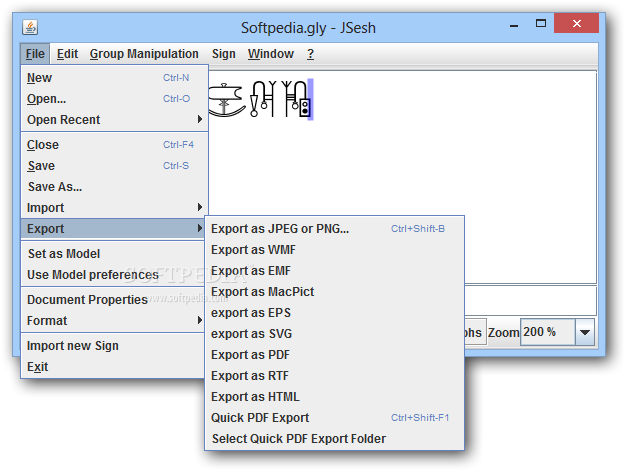

It uses more than 800 hieroglyphs (from Gardiner's Sign list). It is not a text processor but a very useful dictionary.
Jsesh download free free#
I have Java installed but can't open it :(, so I use TKsesh:Īnother free and interesting program is Luca Brigatti's HieroWord:
Jsesh download free mac#
JSesh, word processor, uses Java and here you'll find the new version (for Mac and Win):
Jsesh download free software#
Finally, discoveries in Tanis are described, along with some photographs from the Loret and Varille archives that were taken during Pierre Montet’s excavations.Serge Rosmorduc's software for typing hieroglyphs is very useful (and free!). The discovery of Tutankhamun’s tomb is discussed, accompanied by photos of Lacau guiding European royalty at the tomb, which were taken during official visits to Egypt. The mummies and objects found in the "royal cache" of Deir el-Bahri are well documented, not only in the archives but also in the publications of the Milanese library: some plates from these volumes are presented, as well as correspondence between Loret and other scholars about his discoveries in the Valley of the Kings, together with photos, handwritten notes, maps and plans of the tomb of Amnhotep II. Studies of the Pyramids Texts are discussed and exemplified by hieroglyphic columns of these texts handwritten by Victor Loret. Panels from the tomb of Hesyra in Saqqara and the excavation held in his tomb are discussed, accompanied photos from the collections of Varille and James E. Discoveries of Auguste Mariette are described, and photographs of the Serapeum, coffin lid, jewels and weaponry from the tomb Queen Ahhotep are shown, these coming from the collections of Alexandre Varille and Pierre Lacau. The author discusses the story of the great discoveries in Egypt between the mid-19th and mid-20th centuries through documents held in the Egyptological Archives and Library of the University of Milan.

The naos was created in the hope of sustaining the family and perhaps even their relations in the afterlife, assuring them of their continued participation in the cult of Osiris. Tabaketnetast was likely the wife of Sankhuher. Sheritre, a songstress of Osiris, was presumably the wife of Shediwahsu and the mother of daughters Tabaketnetast and Tasethaeitenirriteth. This paper proposes a genealogy for the individuals identified in the naos.

This naos was created and left probably in a tomb at Abydos so that these individuals could benefit presumably from being in the presence of the sacred realm of Osiris, the truly good brother, lord of provisions, and eternity, and could participate in the rituals and mysteries of Osiris at Abydos. Transliteration, translation, and discussion of the naos are presented. The three scenes exhibit three epithets or manifestations of the god Osiris: the truly good brother, lord of provisions, and lord of eternity. The figures represented are inscribed on the surface of the clay naos. The funerary naos commemorates several individuals, including three women: Tabaketnetast, Tasethaeitenirriteth, and Sheritre, and two men: Sankhuher and Shediwahsu. Mariette among the stelae of the songstresses of Osiris at Shunet el-Zebib, Abydos, dating to the late Twentieth Dynasty. Publication of the Egyptian Museum in Cairo naos CG 70041 of the goldsmith Sankhuher, found in the so-called “nécropole des chanteuses” by A. Combining information from archives and museums it is now possible to follow the path of numerous objects: of some of them, we can identify the owner(s), and eventually find out where they are kept at present of others, sold to public museums, it is possible to establish the original provenance and trace their way from the ancient sites to the Cairo Museum Sale Room, and then to antiquities dealers, auctions, different owners, up to their final location. This register provides the photographs, a short description, and the names of the buyers of items that were judged saleable, as “duplicates” of objects already present in the Collection. Most likely opened at the end of 1892 (even if official sales of objects took place since around 1883), it was active until 1979. A research project on these objects, now scattered around the world, started with the examination of the copy of some pages of the register of the Cairo Museum Sale Room. Notes, letters and photographs related to Egyptian antiquities that found their way into public or private collections, or whose location is unknown at present, are housed in the Loret, Quibell, Varille and Bothmer archives preserved in the Università degli Studi di Milano.


 0 kommentar(er)
0 kommentar(er)
